
Lasius is a genus of formicine ants. The type species for this genus is the black garden ant, Lasius niger. Other major members, which live in drier heathland, are the cornfield ant, L. neoniger, and L. alienus. Other species include the temporary social parasites of the L. mixtus group and the hyper-social parasite Lasius fuliginosus. Lasius flavus is also a commonly seen species, building grassy hillocks in undisturbed pasture. In the Alps, these mounds - always aligned east to catch the first rays of the rising sun - have been traditionally used by goatherds as natural compasses. Species in the subgenus Acanthomyops, in particular L. interjectus and L. claviger, are commonly known as citronella ants due to their citronella-like smell.
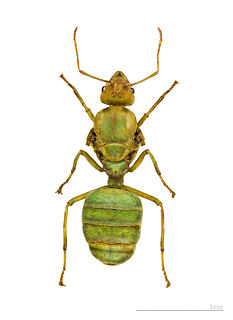
A queen ant is an adult, reproducing female ant in an ant colony; generally she will be the mother of all the other ants in that colony. Some female ants, such as the Cataglyphis, do not need to mate to produce offspring, reproducing through asexual parthenogenesis or cloning, and all of those offspring will be female. Others, like those in the genus Crematogaster, mate in a nuptial flight. Queen offspring ants develop from larvae specially fed in order to become sexually mature among most species. Depending on the species, there can be either a single mother queen, or potentially hundreds of fertile queens in some species. A queen of Lasius niger was held in captivity by German entomologist Hermann Appel for 283⁄4 years; also a Pogonomyrmex owyheei has a maximum estimated longevity of 30 years in the field.
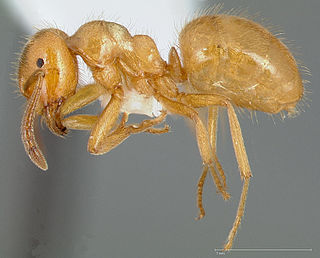
Lasius latipes is a species of ant in the genus Lasius. It is native to the United States.
Lasius murphyi is a species of ant in the genus Lasius. It is endemic to the United States and Canada.

Lasius arizonicus is a species of ant belonging to the genus Lasius, formerly a part of the genus Acanthomyops. Described in 1917 by Wheeler, the species is native to the United States.

Lasius californicus is a species of ant belonging to the genus Lasius, and was formerly a part of the genus Acanthomyops. Described in 1917 by Wheeler, the species is native to the United States.

Lasius claviger, or the smaller yellow ant, is a species of ant belonging to the genus Lasius, formerly a part of the genus Acanthomyops. Described in 1862 by Roger, the species is native to the United States.
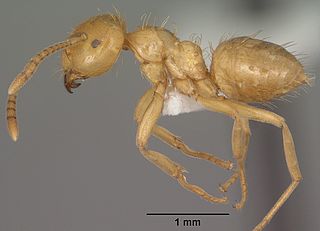
Lasius colei is a species of ant belonging to the genus Lasius, formerly a part of the genus Acanthomyops. Described in 1968 by Wing, the species is native to the United States.
Lasius coloradensis is a species of ant belonging to the genus Lasius, formerly a part of the genus Acanthomyops. Described in 1917 by Wheeler, the species is native to the United States. The queens of will make a claustral chamber and hibernate, laying eggs in the spring.

Lasius creightoni is a species of ant belonging to the genus Lasius, formerly a part of the genus Acanthomyops. Described in 1968 by Wing, the species is native to the United States.
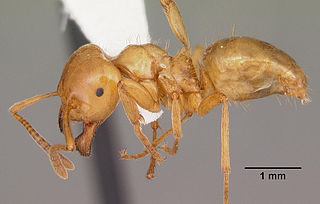
Lasius interjectus, commonly known as the larger yellow ant, is a species of ant belonging to the genus Lasius, and was formerly a part of the genus Acanthomyops. Described in 1866 by Mayr, the species is native to the United States.
Lasius mexicanus is a species of ant belonging to the genus Lasius, formerly a part of the genus Acanthomyops. Described in 1914 by William Morton Wheeler, the species is native to Mexico.

Lasius occidentalis is a species of ant belonging to the genus Lasius, formerly a part of the genus Acanthomyops. Described in 1909 by Wheeler, the species is native to the United States.

Lasius plumopilosus is a species of ant belonging to the genus Lasius, formerly a part of the genus Acanthomyops. Described in 1941 by Buren, the species is native to the United States, notably from the state of Iowa.

Lasius pogonogynus is a species of ant belonging to the genus Lasius, formerly part of the genus Acanthomyops. Described in 1950 by Buren, the species is native to the United States.
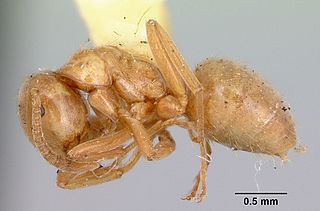
Lasius pubescens is a species of ant belonging to the genus Lasius, formerly a part of the genus Acanthomyops. Described in 1942 by Buren, the species is native to the United States.
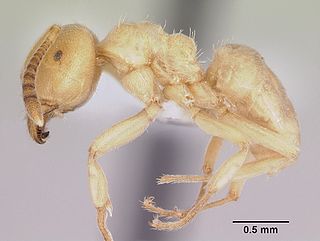
Lasius subglaber is a species of ant belonging to the genus Lasius, formerly a part of the genus Acanthomyops. Described in 1893 by Emery, the species is native to the United States and Canada.
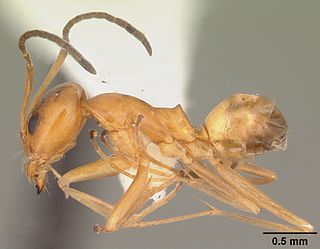
Dorymyrmex bureni also known as pyramid ant is a species of ant in the genus Dorymyrmex. Described by Trager in 1988, the species is endemic to the United States and Mexico. Pyramid ants are medium-sized ants, ranging from 2–4 mm. They are light orange in color and fast moving. Unlike other ants in the area like red imported fire ants, this species is not aggressive towards humans. The workers have a foul smelling coconut odor when crushed. Dorymyrmex bureni hunt living insects, even other winged ants. They also search for sap-sucking insects from which they collect honeydew. On the head of these ants are curved hairs, used for transporting beads of damp sand. Colonies are small. Nests usually have a single entrance with a mound of sand shaped like a crater. Dorymyrmex bureni prefer sandy soil. This species of ant is not an indoor pest, and pesticides should not be used. They are found throughout Florida.
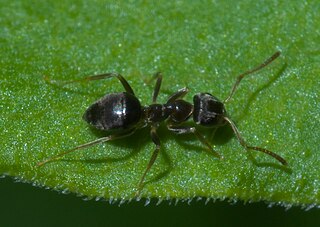
Lasiini is a tribe of ants in the family Formicidae. There are about 10 genera and more than 450 described species in Lasiini.
















